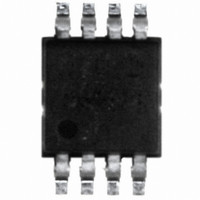DS620U+T&R Maxim Integrated Products, DS620U+T&R Datasheet - Page 6

DS620U+T&R
Manufacturer Part Number
DS620U+T&R
Description
IC THERMOMETER/STAT DIG 8MSOP
Manufacturer
Maxim Integrated Products
Datasheet
1.DS620U.pdf
(15 pages)
Specifications of DS620U+T&R
Function
Thermometer, Thermostat
Topology
ADC (Sigma Delta), Register Bank
Sensor Type
Internal
Sensing Temperature
-55°C ~ 125°C
Output Type
I²C™/SMBus™
Output Alarm
No
Output Fan
No
Voltage - Supply
1.7 V ~ 3.5 V
Operating Temperature
-55°C ~ 125°C
Mounting Type
Surface Mount
Package / Case
8-MSOP Exposed Pad, 8-HMSOP, 8-eMSOP
Full Temp Accuracy
+/- 2 C
Digital Output - Bus Interface
Serial (2-Wire)
Digital Output - Number Of Bits
13 bit
Maximum Operating Temperature
+ 125 C
Minimum Operating Temperature
- 55 C
Lead Free Status / RoHS Status
Lead free / RoHS Compliant
the device enters a low-power standby state and remains in that state until a temperature conversion is again
initiated by a Start Convert command.
The R0 and R1 bits in the configuration register allow the user to set the conversion resolution to be 10, 11, 12, or
13 bits (0.5°C, 0.25°C, 0.125°C, and 0.0625°C LSb weight, respectively) as shown in Table 6. The default
resolution at power-up is 13-bits. Note that the conversion time doubles for each additional bit of resolution.
After each conversion, the digital temperature is stored as a 16-bit two’s complement number in the 2-byte
temperature register as shown in Figure 3. The temperature register is located in address spaces AAh (MSB) and
ABh (LSB) of the DS620 memory. The sign bit (S) indicates if the temperature is positive (S = 0) or negative (S =
1). Bits 2, 1, and 0 of the temperature register are hardwired to 0. When the device is configured for 13-bit
resolution, the 13 MSbs (bits 15 through 3) of the temperature register will contain temperature data. For 12-bit
resolution, the 12 MSbs (bits 15 through 4) of the temperature register will contain data, and bit 3 will be 0.
Likewise, for 11-bit resolution, the 11 MSbs (bits 15 through 5) will contain data, and for 10-bit the 10 MSbs (bits 15
through 6) will contain data, and all unused LSbs will contain 0s. Table 2 gives examples of 13-bit resolution output
data and the corresponding temperatures.
Figure 3. Temperature, T
Table 2. 13-Bit Resolution Temperature/Data Relationship
WRITING TO THE TEMPERATURE REGISTER
The user is given access to write to the DS620 temperature register. This feature can be used for system test and
debugging by allowing the user to force the temperature reading above or below fault thresholds without having to
heat or cool the device.
If data is written to the temperature register while conversions are in progress, the result of the next completed
conversion will overwrite any data that was written to the temperature register. Additionally, no update of the flag
bits in the configuration register, nor an update of the PO pin occur as a result of the temperature being written if a
conversion is taking place. To avoid this from happening, conversions should first be stopped before writing to the
temperature register. When writing to the temperature register, both the MSB and the LSB should be written. An
update of the flag bits and PO pin will only occur after the LSB has been written. See Writing to the DS620 for more
information.
MS Byte
LS Byte
bit 15
bit 7
2
S
Temperature (°C)
0
+25.0625
-25.0625
+10.125
-10.125
+125
+0.5
-0.5
-55
0
bit 14
bit 6
2
2
H
-1
7
, And T
L
bit 13
bit 5
Register Format
2
2
-2
Digital Output (binary)
6
0011 1110 1000 0000
0000 1100 1000 1000
0000 0101 0001 0000
0000 0000 0100 0000
0000 0000 0000 0000
1111 1111 1100 0000
1111 1010 1111 0000
1111 0011 0111 1000
1110 0100 1000 0000
6 of 15
Bit 12
Bit 4
2
2
-3
5
bit 11
bit 3
2
2
-4
4
Digital Output (hex)
bit 10
bit 2
FFC0h
FAF0h
3E80h
0C88h
E480h
0510h
0040h
0000h
F378h
2
0
3
bit 9
bit 1
2
0
2
bit 8
bit 0
2
0
1












